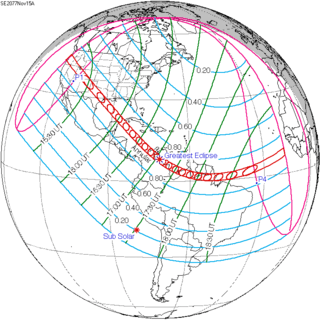Solar eclipse of May 1, 2079
| Solar eclipse of May 1, 2079 | |
|---|---|
 Map | |
| Type of eclipse | |
| Nature | Total |
| Gamma | 0.9081 |
| Magnitude | 1.0512 |
| Maximum eclipse | |
| Duration | 175 sec (2 m 55 s) |
| Coordinates | 66°12′N 46°18′W / 66.2°N 46.3°W |
| Max. width of band | 406 km (252 mi) |
| Times (UTC) | |
| Greatest eclipse | 10:50:13 |
| References | |
| Saros | 149 (24 of 71) |
| Catalog # (SE5000) | 9685 |
A total solar eclipse will occur on May 1, 2079. A solar eclipse occurs when the Moon passes between Earth and the Sun, thereby totally or partly obscuring the image of the Sun for a viewer on Earth. A total solar eclipse occurs when the Moon's apparent diameter is larger than the Sun's, blocking all direct sunlight, turning day into darkness. Totality occurs in a narrow path across Earth's surface, with the partial solar eclipse visible over a surrounding region thousands of kilometres wide. The eclipse will be visible in Greenland, parts of eastern Canada (including Newfoundland and Labrador, New Brunswick, Nova Scotia and Prince Edward Island) and parts of the northeastern United States (including Maine, New Hampshire, Vermont, Connecticut, Rhode Island, Massachusetts, New York, Pennsylvania and New Jersey).
Related eclipses
Solar eclipses 2076-2079
Each member in a semester series of solar eclipses repeats approximately every 177 days and 4 hours (a semester) at alternating nodes of the Moon's orbit.
| 119 | June 1, 2076 Partial |
124 | November 26, 2076 Partial |
| 129 | May 22, 2077 Total |
134 | November 15, 2077 Annular |
| 139 | May 11, 2078 Total |
144 | November 4, 2078 Annular |
| 149 | May 1, 2079 Total |
154 | October 24, 2079 Annular |
Notes
References
- Earth visibility chart and eclipse statistics Eclipse Predictions by Fred Espenak, NASA/GSFC
